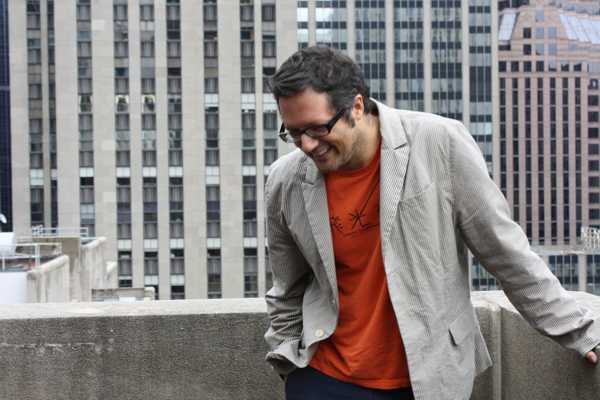Concrete Playground Talks to Artist Rafael Lozano-Hemmer
Lozano-Hemmer is famous for art that lurks in public spaces, galleries and even beaches, amplifying passers-by into new creatures with a city-sized will.
Concrete Playground recently caught up with Mexican-Canadian tech artist Rafael Lozano-Hemmer. Lozano-Hemmer is famous for art that lurks in public spaces, galleries and even beaches, amplifying passers-by into new creatures with a city-sized will. He's taking over a slice of the as-yet unfinished Museum of Contemporary Art over summer, with his hands-on exhibition Recorders. Lozano-Hemmer mashes-up tech, art and his audience, with an effortlessness that would leave the mechanism invisible — if he didn't then go on to scrupulously explain, in-situ, how his works work.
How would you describe what do you do?
I work primarily with the intersection of architecture and performance art. Most of my installations are in the form of either displays or lights, or sounds that react to the presence of the public. And to do that there are things like sensors and tracking systems, and biometric scanners which allow the artworks to detect the presence of people.
I like always to reveal the mechanisms by which these works function. So oftentimes in my work you get to see the tracking systems, or you get explanations about what equations are at work to make a project happen. I pretentiously call it a 'Brechtian moment'. You remember how in Brecht, all of a sudden all the actors stop and just look at the public and say "Well, you know, this situation is just make believe. This is just a simulation of reality. We are actors. You're the public." So there's this moment where you all get back, anchored in reality.
You've said one of the things you liked about an outdoor work of yours was that you had people outside in public, just hanging around and not shopping. It must be very interesting for you, watching the Occupy movements around the world.
When it first started in Spain in May it was just so exciting. I'm from Latin America, so oftentimes protests and so on turn out to be these ideology-based, adversarial kinds of movements. And that's not what I saw with the Occupy movement, when it started in Spain. With the indignados ('indignant ones') it was mostly professionals, architects, dentists, students, professors, whatever. And they were just taking over public space. And that was just such a beautiful statement, and they did so in such a sophisticated way.
The indignados started in Madrid, where there's a tradition of young people going out and drinking in the streets.
There's a sense of ownership of the street. Real estate was so expensive that everybody lives with their parents. And so you needed to go out in order to see your friends. And that produced very lively street life. But it's also just a sense of being seen.
It's almost as if the actual protest is the message all by itself. Just a we're here.
Yeah. Just this idea of just occupying space is radical. You know, you're there. You're existing. Just spending time, and connecting, and being present, is in my opinion extremely radical.
Especially in Latin countries where people used to just disappear under the dictators, the idea of just being there..
That's a really good way to understand the sense of presence and absence, in terms of the political dialogue. It's like "Yeah, what are you going to do? You cannot wipe us out. We think these things, and therefore we are taking space. These ideas take space."
I just came back from Art Basel Miami Beach. Which is this art fair. I mean, I'm not a moralist. And I love money. And I love champagne as much as the next guy, but there is something really absurd about a system that only reserves this sort of superior cultural production to this tiny fraction of the population. And I'm telling you this because there was an Occupy Art Basel Miami.
There were all these artists. You know, local artists and so on, and educators, camping out of Art Basel Miami saying "We can't afford the 50 bucks it costs to go in. And, even if we could, we would never be able to afford any of the art that is on display here."
Something else you try to bring to people's awareness is the surveillance around them all the time.
These technologies come mostly from a desire to control the public, a desire to seek out, search and detect suspicious activity. The surveillance aspect of my work is more about acknowledging this kind of darker, predetorial side of where these things come from. But then creating critical or poetic experiences with these very same technologies.
I would love people to come out of Recorders with a sense of inclusion, a sense that these technologies are neither this Orwellian, ominous threat — it's already happened — and also not like an infantile, fun, hands on science experiment thing. In between those two extremes, there's a whole range of different poetry that is possible.
Image courtesy and © Rafael Lozano-Hemmer. Photo: Ana Cristina Enriquez





